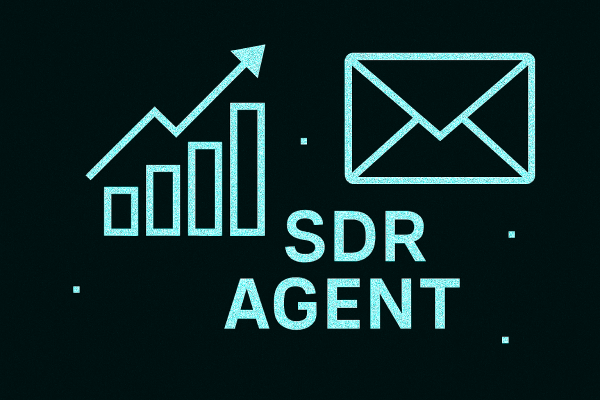
Sales Development Representative
🤖 SDR Agent
This agent takes data from Clay and (1) generates a company fit analysis and (2) generates a custom campaign email to send to individual prospects.
Overview
Skip all the stuff below and watch this step-by-step walkthrough of how to deploy your own version of this agent.
Customization
Edit the source code for both agents to customize the prompts for your specific use-case, then deploy your project to Agentuity (agentuity deploy). Open each agent in the Agentuity web app and edit the I/O: first remove the default webhooks, then add a new API input. It is highly recommended to add authorization your the API endpoints.
Analysis Agent Configuration in Clay
The fit analysis agent runs on Companies.
Step 1: Request
Create a new HTTP API enrichment in Clay after you've enriched the company. Edit the HTTP API enrichment and set the Method to POST, the Endpoint to the URL of your agent-sdr-analysis agent's API I/O, add the Headers for Content-Type and (if applicable) Authorization (also from the API I/O), and begin populating the Body.
The Body should be a JSON object with company variables (which can be added via the / command), for example:
{
"name": "Cyan",
"industry": "Healthcare Software",
"description": "Cyan is a healthcare technology company...",
"domain": "cyanhealthcaresoftware.com",
...
}
The more data you pass to the agent from Clay, the better the returned analysis will be. Your JSON structure should be clearly organized and have descriptive names for keys so the agent understands the data you're passing without the need for a schema. The analysis agent has web browsing capabilities, so feel free to include URLs (company website, LinkedIn, etc).
For examples of the above, reference the default examples in the top part of the agent code.
Step 2: Response
After the HTTP API enrichment column is created from the steps above, add 8 new Text columns and edit them. In the content area, type /HTTP API and choose your returned property (e.g. primary_messaging). You can also edit the column names to be more descriptive.
That's it! Pass these new columns along to the email agent in the next steps.
Email Agent Configuration in Clay
The email agent runs on People.
Step 1: Request
Create a new HTTP API enrichment in Clay after you've enriched both the company and person. Edit the HTTP API enrichment and set the Method to POST, the Endpoint to the URL of your agent-sdr-email agent's API I/O, add the Headers for Content-Type and (if applicable) Authorization (also from the API I/O), and begin populating the Body.
The Body should be a JSON object with variables (which can be added via the / command), for example:
{
"person": {
"first_name": "Jane Doe",
"role": "CTO",
"company": "Cyan, Inc.",
...
},
"prompt": "Be formal, but excited!...",
"analysis": {
"prospect_fit": "Cyan is a behavioral health and technology company that...",
...
}
}
The more data you pass to the agent from Clay, the better the returned email body content will be. Your person JSON structure should be clearly organized and have descriptive names for keys so the agent understands the data you're passing without the need for a schema.
You can also set a prompt property which contains information specific to the email campaign you're generating. It is suggested you use Markdown, and specify exactly what your parameters are for each part of the email.
Finally, you should include analysis, which can contain any information you want about the company or the person you're targeting; we recommend using the included agent-sdr-analysis agent, but you can generate it however you wish. The data should include information like prospect fit, pain points, or key focus areas for the pitch. As with the person property, using descriptive key names is helpful.
For examples of the above, reference the default examples in the top part of the agent code.
Step 2: Response
After the HTTP API enrichment column is created from the steps above, add 5 new Text columns and edit them. In the content area, type /HTTP API and choose your returned property (e.g. subject). You can also edit the column names to be more descriptive. These are the columns that you will pass to your email campaign platform.
That's it! You can now use the email content in your workflows.
📋 Prerequisites
Before you begin, ensure you have the following installed:
- Bun: Version 1.2.4 or higher
🚀 Getting Started
Authentication
Before using Agentuity, you need to authenticate:
This command will open a browser window where you can log in to your Agentuity account.
Creating a New Agent
To create a new agent in your project:
Follow the interactive prompts to configure your agent.
Development Mode
Run your project in development mode with:
This will start your project and open a new browser window connecting your agent to the Agentuity Console in DevMode, allowing you to test and debug your agent in real-time.
🌐 Deployment
When you're ready to deploy your agent to the Agentuity Cloud:
This command will bundle your agent and deploy it to the cloud, making it accessible via the Agentuity platform.
📚 Project Structure
├── agents/ # Agent definitions and implementations
├── node_modules/ # Dependencies
├── package.json # Project dependencies and scripts
└── agentuity.yaml # Agentuity project configuration
🔧 Configuration
Your project configuration is stored in agentuity.yaml. This file defines your agents, development settings, and deployment configuration.
📖 Documentation
For comprehensive documentation on the Agentuity JavaScript SDK, visit: https://agentuity.dev/SDKs/javascript
🆘 Troubleshooting
If you encounter any issues:
- Check the documentation
- Join our Discord community for support
- Contact the Agentuity support team
📝 License
This project is licensed under the terms specified in the LICENSE file.
